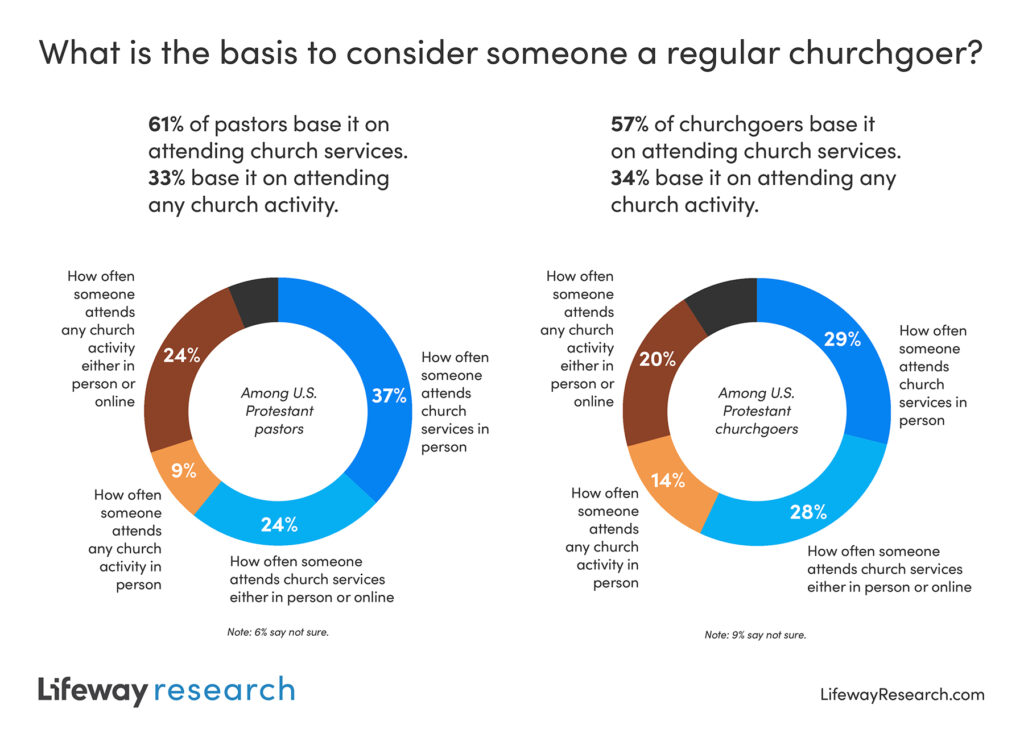On the other end of the spectrum, mainline pastors (30%) are more likely than their evangelical counterparts (20%) to include those who attend once a month among regular churchgoers.
Additionally, pastors at small and normative-sized churches are among the most likely to believe monthly attendance makes someone a regular attender. Around a quarter of those at churches with less than 50 people (27%) and those at congregations of 50 to 99 (27%) say someone who attends once a month is a regular churchgoer.
When thinking about what exactly someone must attend to be considered an attender, most pastors look to church services rather than other activities. Six in 10 U.S. Protestant pastors (61%) say they base their idea of a regular churchgoer on how often someone attends a church service. Less than 2 in 5 pastors (37%) consider strictly in-person attendance, while around 1 in 4 (24%) also factor in online attendance. A third (33%) look at how often they attend any church activity, with 9% pointing to in-person attendance and 24% basing it on physical or online involvement. Few (6%) say they aren’t sure.
Younger pastors, those 18-44, are among the most likely to base their churchgoer definition on attending church services in person (42%) and among the least likely to include online worship service attendance (17%). Evangelical pastors (45%) are also more likely than mainline pastors (25%) to point to physically attending church services.
View From the Pews
Churchgoers themselves are likely to place the standard of regular church attendance near their own frequency. In a study of those who attend church at least once a month, 86% say a regular churchgoer is someone who attends once a month or more. Specifically, 60% of respondents attend weekly or more, and 68% of those who attend weekly or more consider someone to be a regular churchgoer if they attend with the same regularity.
The more frequently a churchgoer attends services the more likely they are to place a higher threshold for being considered a regular church attender. Yet, even among those who attend less than weekly, a large portion identify weekly or more as the standard for a regular attendee. More than 2 in 5 of those who attend one time a month (47%), two times a month (41%) or three times a month (48%) point to the weekly or more standard.
“The study of churchgoers only provides insights from those attending each month, but there seems to be a consensus among that group that a regular churchgoer should be involved in the life of a congregation more often than not,” said McConnell. “Pastors’ perceptions of a regular churchgoer often appear broader, while those in the pew lean closer to a weekly standard.”

Hispanic (21%) and African American churchgoers (20%) are around twice as likely as white churchgoers (11%) to say being a regular churchgoer requires attending more than once a week. Churchgoers with evangelical beliefs (55%) are more likely than those without evangelical beliefs (38%) to say the standard is weekly attendance.
Similarly to pastors, churchgoers are more likely to connect being a regular church attender with attending church services rather than other activities. Most (57%) use the church service as their basis, including 29% who focus exclusively on in-person attendance and 28% who include attending services online. Around a third (34%) focus on any type of church activity, with 14% pointing to only in-person attendance and 20% including online attendance. Around 1 in 10 (9%) aren’t sure.
Churchgoers with evangelical beliefs (33%) are more likely than those without (26%) to base regular churchgoing on how often someone attends church services in person.
For more information view the pastor report and churchgoer report.
This article originally appeared here.

